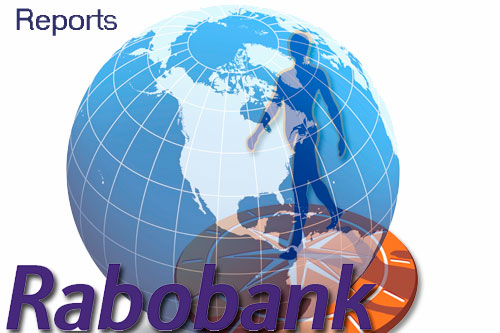Rabobank: Dairy Q2 prices historically high

International dairy prices peaked at record levels in April, just ten months after the last market trough. Although in mid-June prices fell by 10-12%, they still remained exceptionally high by historic standards, according to Rabobank’s latest quarterly dairy report.
The price rally is unusually supply-side driven, with significant falls in milk production in both export and import regions effectively shorting the market, despite very weak demand. Prices are expected to drift downwards as supply improves over the next two quarters, but change is likely to be gradual.
Tim Hunt, Rabobank global strategist, commented: “Seldom has a rally in international markets appeared so supply-side driven as this one. A loss of momentum in milk production growth was expected following an unattractive milk-to-feed cost ratio in late 2012, but this has been exacerbated by atrocious weather in key growing areas in the first half of 2013. In the Northern Hemisphere a cold and wet winter was followed by a late arriving spring, while Oceania saw a summer drought.”
With all supply engines in reverse, bar a marginal increase in Brazil, milk production fell by 2.5% in March then 4.1% in April in the “Big Seven” export regions of the world – the EU, US, New Zealand, Australia, Argentina, Brazil and Uruguay. This is around four times the rate of contraction seen in the aftermath of the global financial crisis.
To make matters worse, battered by adverse weather and poor margins, Russian production fell at a similar rate during the same period, while Chinese production appears to have stagnated at best. This shorted supply in the world’s two largest import regions and sent them scurrying to the international market to top up just as exportable supply dried up. Many other importers were squeezed out of the market, with prices leaping to record levels to ration available supply.
Prices generally start to decline as, in rough order, short term coverage ends, some buyers are pushed to the sidelines, stocks are drawn down wherever possible, and supply eventually improves. However, with the relatively low level of stocks worldwide, the market has been left waiting for the supply response to improved prices.
With a substantial reduction in commodity feed prices expected when Northern Hemisphere crops are harvested in fall, Rabobank expects margins to be positive in most regions by Q4 this year. With only a small improvement expected in demand conditions in the EU and US markets in the second half of the year, pricing will be heavily influenced by the response of milk producers to these improved margins and the appetite of importers to soak up increased volumes. In Rabobank’s view, this is likely to look more like a deflating than a puncturing of international prices.
Source: Rabobank











